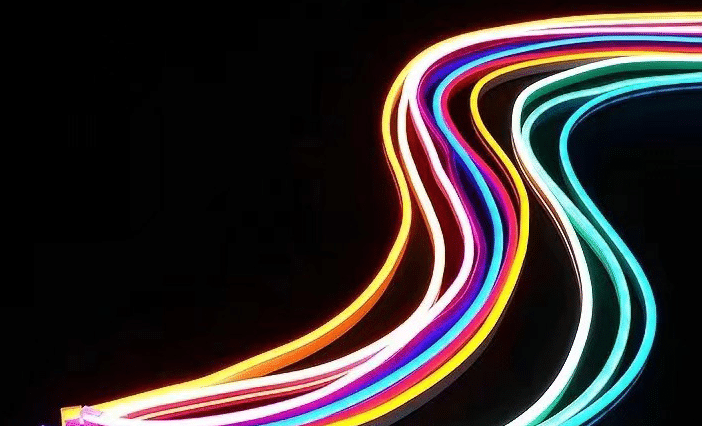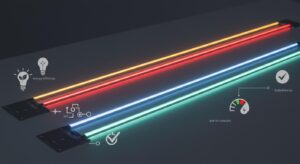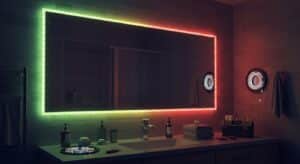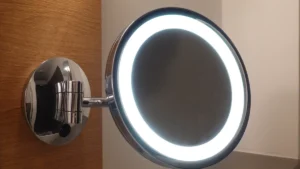
When purchasing bulk LED strip light rolls, it is essential to know the details. Good LED strips should provide at least 450 lumens per foot, which is as bright as a T8 fluorescent lamp. Check how many LEDs are on each metre of the strip; more LEDs result in better light distribution and eliminate dark spots. Compare factors such as brightness, colour quality (CRI), and warranty to make an informed decision.
Buying bulk LED strip light rolls not only saves money but also ensures you have enough for your project. Acquiring more at once reduces the cost per metre. Trusted sellers make the process easy and stress-free, offering strong, reliable products that meet your requirements.
Key Takeaways
Pick LED strips with at least 450 lumens per foot. This gives bright light, like a T8 fluorescent bulb.
Choose the right voltage (12V or 24V) for your project. Use 12V for short lengths and 24V for longer ones.
Think about colour temperature. Warm light (2700K-3000K) feels cosy. Cool light (4000K-5000K) helps you focus better.
Plan your setup by measuring carefully. Cut only at marked spots to avoid ruining the strips.
Buy from trusted shops with good warranties. This ensures quality and safe delivery of your LED strips.
Understanding LED Strip Light Specifications

Voltage and Power Requirements
Why voltage matters for compatibility
Voltage is important to make LED strip lights work well. Using the wrong voltage can harm the strips or shorten their life. For example, a 12V LED strip needs a 12V power source. If the voltage doesn’t match, it may overheat or dim. Always check the voltage of your LED strips before buying.
Common voltage choices for LED strip lights
LED strip lights usually come in 12V and 24V options. A 12V strip is cheaper, flexible, and good for short distances. But it might lose power over long runs. A 24V strip is brighter and works better for longer distances without losing power. It’s more efficient but needs careful handling due to higher voltage. Other options like 5V or 48V are for special uses and need specific power sources.
Voltage Option | Benefits | Things to Consider |
|---|---|---|
12V | Safe, affordable, flexible | Power loss over long distances |
24V | Brighter, longer runs, efficient | Costs more, less compatible |
Other Options | Special uses | Needs special power supplies |
Brightness and Beam Angle
Checking lumens for brightness
The brightness of LED strips is measured in lumens. A good strip should give at least 450 lumens per foot, like a T8 fluorescent light. For accent lighting, 200 lumens per foot is enough. General lighting depends on how far and where the light is aimed. Always check lumens to ensure the strip meets your needs.
How beam angle affects light spread
Beam angle shows how light spreads from the strip. Narrow angles, like 5 to 45 degrees, focus light on small areas. Wide angles, like 80 to 130 degrees, spread light evenly, great for general lighting. Picking the right beam angle helps light your space properly.
Types of LED Strip Lights
Single-colour, RGB, and RGBW choices
LED strips come in different types for various uses. Single-colour strips give one steady colour, perfect for tasks. RGB strips mix red, green, and blue for bright colours. RGBW strips add a white LED for colourful and plain lighting options.
Flexible vs. rigid LED strip rolls
Flexible LED strips bend easily, making them great for curved or tight spaces. They are simple to install and used in homes and businesses. Rigid LED strips are fixed on hard surfaces. They are strong and good for tough, stable lighting needs.
Colour Temperature and Ambiance
Picking the right colour temperature
Colour temperature shows how light looks, measured in Kelvin (K). Lower Kelvin numbers, like 2700K to 3000K, give warm, yellow light. This is great for cosy spaces like bedrooms or living rooms. Higher Kelvin numbers, like 4000K to 5000K, give cool, blue light. These are better for work areas like kitchens or offices.
Think about the room’s purpose when choosing colour temperature. For example:
Warm white (2700K-3000K): Great for calm, relaxing spaces.
Cool white (4000K-5000K): Ideal for places needing focus and energy.
Daylight (5000K-6500K): Best for bright, natural light in workshops or outdoors.
Tip: Always check the Kelvin number on the LED strip box. This ensures you get the lighting effect you want.
How colour temperature affects mood and space
The colour temperature of LED lights changes how a room feels. Warm light makes a space feel cosy and relaxing, perfect for resting. Cool light helps you focus and feel energised, so it’s good for workspaces.
Colour temperature also changes how big or small a room feels. Warm tones make a room feel smaller and snug. Cool tones make spaces look bigger and more open.
Note: Using different colour temperatures in one room can look messy. Stick to one tone for a balanced look.
Installation Tips for LED Strip Lights

Planning the Installation Layout
Measuring and cutting LED strip light rolls
Measuring correctly is very important for a good setup. Use a tape measure to find the exact length you need. Measure twice to avoid mistakes and wasting materials. LED strips have special cutting points marked on them. Always cut at these points to avoid damaging the strip.
Before starting, plan where the strips will go. Measure the area and decide the purpose of the lighting. This helps the strips fit well and avoids changes later.
Choosing the right length and width
Pick the right size of LED strips for your project. Narrow strips are good for accent lighting. Wider strips work better for general or task lighting. Think about the space and the look you want when choosing.
Installation Technique | Key Points to Remember |
|---|---|
Distance from Walls | Keep at least one inch away for even light. |
Cove Lighting | Place strips three-quarters of an inch from walls for a smooth glow. |
Accent Lighting | Put strips above or below features to highlight them. |
Task Lighting | Place strips at the back edge of desks for soft light. |
Surface Preparation | Clean and smooth surfaces for better sticking. |
Tip: Try different heights for cove lighting to get soft, even light.
Water Resistance and Durability
Understanding IP ratings for indoor and outdoor use
IP ratings show how well strips resist dust and water. For indoors, IP20-rated strips are fine. For outdoors or wet areas, use IP65 or IP67-rated strips.
IP Rating | What It Means | Where to Use |
|---|---|---|
IP65 | Resists water jets from any angle | Outdoor areas, not for underwater use |
IP67 | Handles brief water submersion | Damp places with occasional water exposure |
IP68 | Fully waterproof up to 3 metres | Areas needing full water protection |
Manufacturers test these ratings to ensure safety and strength. Higher IP ratings are better for dusty or wet places.
Selecting durable strips for long-term performance
Strong LED strips last longer and work better. Choose strips made with good materials and strong adhesive. For outdoor use, pick UV-resistant strips to avoid sun damage.
Power Source and Wiring
Selecting the appropriate power supply
Get a power supply that matches your LED strip’s voltage and power needs. Add up the total power your strips use and pick a supply that can handle it. For example, use a 12V power supply for 12V strips.
Ensuring safe and efficient wiring connections
Good wiring keeps your setup safe and working well. Use connectors that fit your LED strips. Make sure all wires are secure to avoid problems. Follow the maker’s instructions to connect everything correctly.
Note: Matching the power supply to the strip’s needs stops overheating and keeps it working well.
Adhesive Backing and Surface Compatibility
Why strong adhesive backing matters
The sticky backing on LED strips is very important. It helps the strips stay in place for a long time. Good-quality strips often use 3M double-sided tape. This tape is easy to use and holds well. Strong adhesive stops the strips from falling off, even in humid or hot places.
A good adhesive keeps the strips steady, so the light stays even. Weak adhesive can make the strips fall or give uneven light. For small spaces, LED strips with strong adhesive are perfect because they fit well and stay put.
How to make sure strips stick properly
To make the strips stick well, clean the surface first. Remove all dust, grease, or water. A clean, smooth surface helps the adhesive stick better. For rough surfaces, use extra clips or brackets to hold the strips.
If using aluminium channels, pick strips with white paint coating. This coating makes the light brighter and clearer. Without it, the light may look dull or uneven in the channels.
For outdoor or wet areas, choose waterproof strips with strong adhesive. These strips last longer and won’t lose stickiness from water or sunlight. Press the strips firmly when sticking them to activate the adhesive fully.
Tip: If the adhesive stops working, use double-sided tape or silicone glue instead.
Choosing the Right Accessories for LED Strip Lights
LED Drivers and Power Supplies
Picking the right driver for LED strips
The correct driver keeps your LED strips safe and working well. First, check the voltage of your LED strips, usually 12V or 24V. Match this with a power supply of the same voltage. Then, add up the total power your strips use. Add 10% extra to pick a power supply that won’t overheat.
Think about how you’ll connect the power supply. Some plug into outlets, while others need wiring. For outdoor or damp areas, choose a power supply with an IP65 rating to resist water. Compact power supplies are better for small spaces, so measure the area first.
Tip: Brands like Mean Well are reliable, with a failure rate under 0.02%. They are a great choice for long-lasting use.
Saving energy and staying safe
Energy-saving power supplies lower electricity bills and make LED strips last longer. Look for features like Power Factor Correction (PFC) and over-voltage protection. These keep your LED strips safe and working steadily. Always follow the maker’s instructions for proper setup.
Motion Sensors and Dimmers
Why motion sensors are useful
Motion sensors make life easier and save energy. They turn on your LED lights when they sense movement and turn them off when no one is around. This is great for hallways, closets, or outdoor spaces. It saves electricity and helps your LED strips last longer.
Adjusting brightness with dimmers
Dimmers let you change how bright your LED strips are. Use dim light for relaxing or bright light for tasks. Dimmers also save energy by using less power. Make sure your LED strips and power supply work with dimmers for smooth use.
Smart Home Integration
Connecting to smart home systems
Smart home systems make controlling LED strips simple. Check if your LED strips work with Alexa, Google Home, or Apple HomeKit. This lets you control them with other smart devices in your home. Compatibility makes everything work together easily.
Using apps and voice commands
Smart LED strips often have apps for customising colours, brightness, and schedules. Voice commands make it even easier. Say things like “Turn on the lights” or “Dim to 50%” to control them. These features make your home modern and convenient.
Buying Bulk LED Strip Light Rolls: Key Considerations
Checking Quality and Reliability
Finding good-quality LED strip lights
When buying many LED strips, focus on quality first. Good strips use top-notch LEDs for steady light and fewer failures. The circuitboard is also important. Boards with enough copper, like 4 oz, handle power better and stop voltage drops. Strips with shiny coatings are brighter and show colours clearly.
Compare details like brightness (lumens), CRI (Colour Rendering Index), and board thickness. These affect how well the strips work and last. If you can’t find this info, ask the seller for test results.
Why certifications matter
Certifications help you know if LED strips are safe and good. Look for marks like CE, RoHS, or UL. These show the product meets safety and quality rules. Certified strips are safer, last longer, and give better value.
Saving Money and Planning Costs
Figuring out cost per metre or roll
Buying in bulk lowers the price per metre or roll. To find this, divide the total cost by the number of metres or rolls. This helps you compare prices and pick the best deal.
Balancing cost and quality
Saving money is great, but don’t pick cheap, bad-quality strips. Low-cost options might not stick well or have poor LEDs. Spending more on good strips means they work better and last longer, saving money over time.
Trusting Suppliers and Warranties
Picking reliable sellers
Good sellers give steady quality. Check reviews and ratings to see if they’re trustworthy. Reliable sellers share clear product details and certifications, so you feel sure about your choice.
Knowing warranty and return rules
Always check the warranty before buying LED strips. A good warranty covers problems and offers replacements if needed. Clear return rules make buying easier and less stressful. These protect your money and give peace of mind.
Shipping and Delivery Options
Checking shipping costs for bulk orders
Shipping fees can affect your budget when buying bulk LED strip lights. Always check these costs before ordering. Some sellers give free shipping for big orders, saving you money. Others charge based on the package’s weight or size.
Compare shipping prices from different sellers to get the best deal. Look for discounts or special offers for bulk purchases. If ordering from another country, think about customs fees and taxes. These extra charges can raise the total cost.
Tip: Request a full shipping quote from the seller. This avoids surprise charges later.
Making sure delivery is fast and safe
Fast delivery is important when you need LED strip lights for a project. Delays can mess up your plans and cause problems. Pick a seller with a good record for quick and reliable shipping. Read reviews to see if they deliver on time.
Safe packaging is also key. LED items are fragile and can break during shipping. Make sure the seller uses strong materials like bubble wrap or foam for protection. Tracking options are useful too. They let you see where your package is and when it will arrive.
Note: Confirm the delivery time with the seller. This ensures your order arrives when needed.
Knowing the details, setup tips, and extras is important when buying bulk LED strip lights. Planning well helps match the strips to your needs, like choosing between 12V or 24V options. Installing carefully, with an LED driver, prevents power issues and keeps the lights working smoothly. Buying in bulk saves money, uses less energy, and works for many purposes. LED strips use less electricity, last longer, and fit different spaces, from indoor designs to outdoor lighting.
Make a checklist before you buy. Add things like voltage, colour temperature, and trusted sellers. Check sellers carefully to ensure good quality and fast delivery. Being prepared helps you choose wisely and get the best results for your project.
FAQ
1. Can LED strip lights be cut to fit smaller spaces?
Yes, you can cut LED strips at special cutting marks. These marks are evenly spaced along the strip. Cutting anywhere else can break the circuit and stop it working. Use sharp scissors or a blade for neat cuts.
2. How do you choose the right colour temperature for a room?
Warm white (2700K–3000K) is great for cosy spaces like bedrooms. Cool white (4000K–5000K) suits kitchens or offices. Daylight (5000K–6500K) works well in workshops or outside. Pick a colour temperature that matches the room’s purpose.
3. Are LED strip lights safe for outdoor use?
Outdoor LED strips need a high IP rating like IP65 or IP67. These ratings protect against water and dust. For heavy rain or underwater use, pick IP68-rated strips. Always check the product details before installing them.
4. What accessories improve LED strip light functionality?
Motion sensors turn lights on only when needed, saving energy. Dimmers let you change brightness for different tasks or moods. Smart home systems allow control with apps or voice commands. These tools make LED strips more useful and efficient.
5. How do you ensure LED strips stick properly?
Clean the surface to remove dust, grease, or water. Press the adhesive firmly to make it stick well. For rough surfaces, add clips or brackets for extra hold. Waterproof strips with strong adhesive are best for wet or outdoor areas.
See Also
Selecting The Perfect LED Strip Lights For Linear Lighting
Effective Installation Tips For RGB LED Strip Lights
Best Practices For Installing LED Strip Lights In 2025



